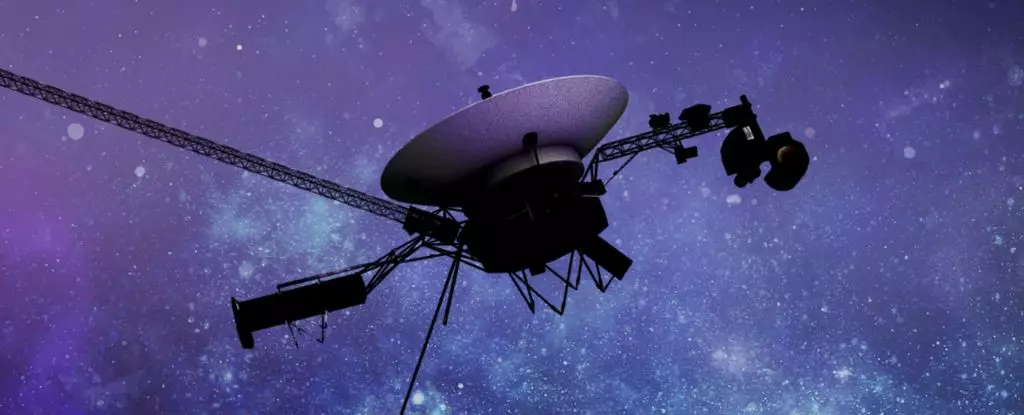In a disconcerting twist for deep space exploration, NASA’s Voyager 1 spacecraft recently experienced a significant communication disruption. This incident, which unfolded over the span of just a few days, serves as a reminder of the unpredictable nature of working with technology that is nearly half a century old. Launched in 1977, Voyager 1 has persistently defied expectations, pushing boundaries and transmitting data from the most distant reaches of interstellar space. However, the recent failure to respond has prompted urgent troubleshooting efforts from the agency.
The drama unfolded on October 16 when NASA sent a command to activate a heater on the craft. Seemingly straightforward, this request led to a communication blackout that took a full two days for the team back on Earth to identify. At almost 25 billion kilometers from our planet, signals to Voyager 1 travel at the speed of light, requiring nearly 23 hours for the message to reach the probe, with an additional 23-hour wait for a reply. The reality of such vast distances places significant constraints on mission management, making every moment critical.
When Voyager 1 failed to respond on October 18, NASA’s Deep Space Network (DSN) kicked into action, searching for any sign of the spacecraft. Eventually, they were able to pick up a signal, albeit on a different frequency. It seems that the environment aboard Voyager 1 became unstable enough for its built-in fault protection system to activate. This safety feature is designed to conserve energy by shutting down non-essential systems if an instrument attempts to draw too much power.
Unfortunately, the essential X-band radio transmitter—Voyager 1’s primary communication line to Earth—suffered the consequences of this energy conservation measure. The spacecraft had reduced its transmission rate and altered its X-band signal in an effort to preserve functionality. While the flight team initially reestablished a connection, they were hit with another wave of setbacks when the signal was lost entirely.
NASA’s engineers speculated that the craft’s safety protocols may have triggered again, forcing Voyager 1 to switch to the S-band transmitter, which notably consumes less energy but is significantly weaker. Given that the probe has not utilized this particular channel for communication since 1981, the team faced a daunting task in attempting to reacquire the craft’s signal.
Despite the challenges inherent in the situation, engineers proved their resilience and expertise by successfully reconnecting with Voyager 1 on October 22. They confirmed that the S-band transmitter was operational, even as they remained wary about switching the X-band transmitter back on until the root of the problem was fully understood. This cautious approach reflects NASA’s broader commitment to preserving the integrity of the Voyager missions, which continue to yield vital scientific insights from uncharted territories.
Yet the reality of aging technology poses a persistent threat to the longevity of the Voyager missions. Over recent years, both probes have endured various technical tribulations, including a 2022 incident where garbled telemetry data was transmitted for several months. As technology in the field of space exploration advances rapidly, maintaining older devices becomes increasingly complex and necessitates an amalgamation of ingenuity and caution.
The significance of the Voyager missions cannot be overstated. As the only human-made objects traversing the uncharted complexities of interstellar space, they have provided invaluable data that has broadened our understanding of cosmic phenomena beyond the influence of our Sun. Strikingly, the power supplies for both probes are projected to dwindle, with data collection anticipated to cease by 2025. By 2036, Voyager 1 and its twin, Voyager 2, are expected to drift beyond the range of DSN tracking—losing contact with the human race altogether.
Looking ahead, the fate of Voyager 1 and Voyager 2 leaves us both in awe and with a hint of melancholy. Upon nearing neighboring stars in about 40,000 years, these spacecraft will represent the ultimate testament to human curiosity and ingenuity, carrying information about our civilization into the cold abyss of space. As they coast through the Oort Cloud, humanity must reconcile the fact that, while our connection with them may fade, they will continue to exist, leaving an enduring legacy that might one day be discovered by other intelligent beings far in the future.
In reflecting on these incidents, it’s essential to recognize that challenges are inherent in such ambitious pursuits. The operational constraints, coupled with the historical significance of the Voyager missions, remind us of our own fragility in the cosmos, as well as the wonders that remain to be unveiled.


Leave a Reply